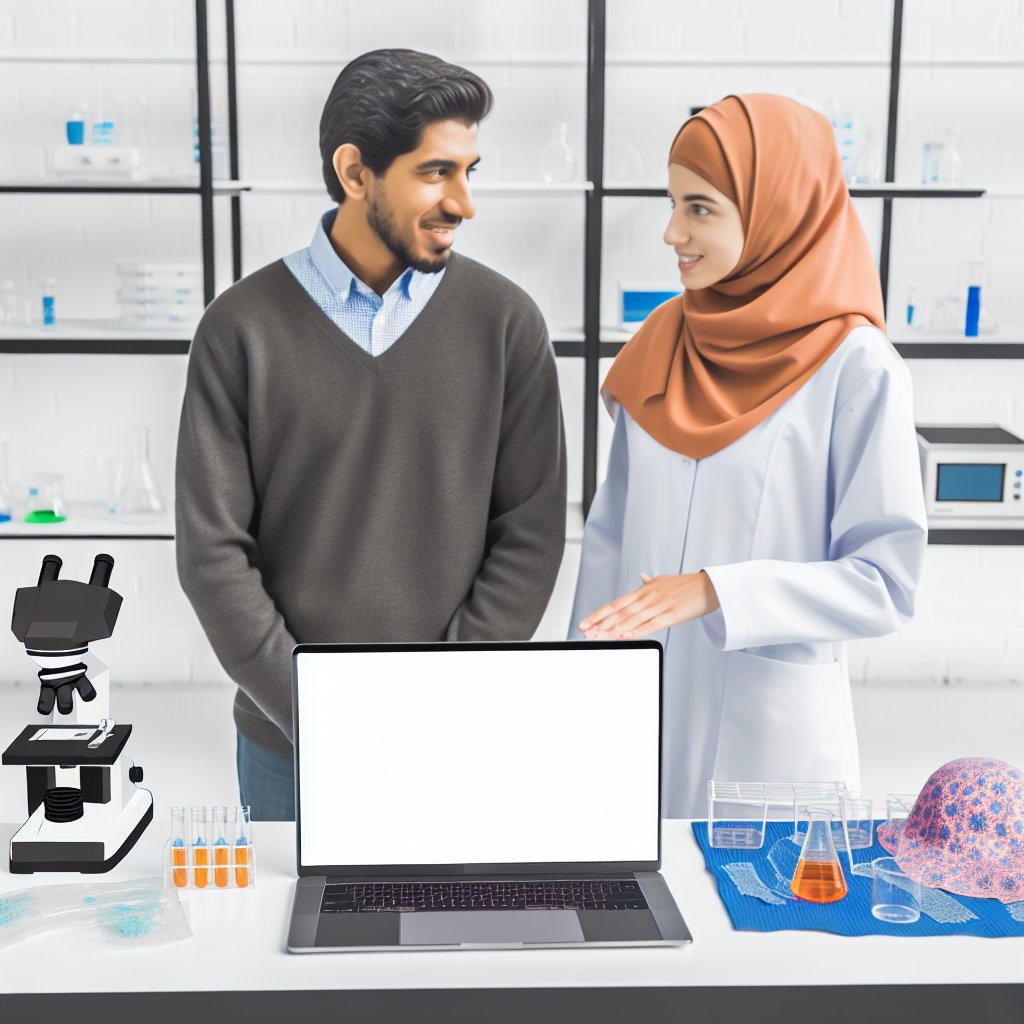Overview of the Biomedical Engineering Field in Australia
Emerging Innovations and Industry Growth
Biomedical engineering in Australia advances rapidly through innovative technologies and research.
Several universities and institutions foster strong biomedical engineering programs nationwide.
For example, the University of Melbourne and the University of Sydney lead cutting-edge biomedical projects.
Consequently, these institutions attract talented engineers passionate about healthcare improvements.
Moreover, Australian companies like MedTech Innovators excel in developing medical devices and software.
These advancements contribute significantly to Australia's status as a biomedical engineering hub.
Diverse Career Opportunities
The field offers careers in medical device design, tissue engineering, and clinical data analysis.
Professionals like Dr. Amanda Liu focus on creating prosthetics tailored to patient needs.
Similarly, bioinformatics experts improve diagnostic tools through advanced data algorithms.
Therefore, biomedical engineers participate in various roles supporting Australian healthcare delivery.
Many also collaborate with hospitals to implement life-saving technologies on-site.
Collaboration Between Industry and Healthcare
Biomedical engineers work closely with healthcare providers to address clinical challenges.
Partnerships between companies like Synapse Medical and Australian hospitals enhance patient outcomes.
For instance, engineers help design more precise surgical instruments and monitoring systems.
Furthermore, this collaboration accelerates the translation of research into practical treatments.
Your Personalized Career Strategy
Unlock your potential with tailored career consulting. Get clear, actionable steps designed for your success. Start now!
Get StartedAs a result, Australian healthcare benefits from continuous innovation and improved patient care.
Focus on Research and Development
Research institutions invest heavily in biomedical technology breakthroughs across Australia.
The CSIRO Medical Technologies division pioneers projects in regenerative medicine and diagnostics.
Additionally, federal grants support startups developing innovative medical devices and software.
This funding encourages engineers like Michael Carter to explore novel health solutions.
Thus, R&D efforts keep Australia competitive in global biomedical engineering markets.
Education and Professional Development
Australian universities emphasize interdisciplinary education combining engineering and life sciences.
Programs include hands-on experience and industry placements to prepare skilled engineers.
Professional bodies such as Engineers Australia provide resources and networking for biomedical engineers.
Moreover, continuous learning opportunities help professionals stay updated on emerging trends.
Consequently, the workforce remains capable of meeting evolving healthcare demands.
Key Technological Innovations Introduced by Biomedical Engineers
Advancements in Medical Imaging
Biomedical engineers develop cutting-edge medical imaging technologies.
They enhance MRI, CT scans, and ultrasound capabilities significantly.
For instance, Sydney-based MedTech Solutions created advanced MRI coils improving image clarity.
Stand Out with a Resume That Gets Results
Your career is worth more than a generic template. Let us craft a resume and cover letter that showcase your unique strengths and help you secure that dream job.
Get HiredConsequently, doctors diagnose diseases earlier and more accurately.
Moreover, innovations reduce patient discomfort and imaging time effectively.
Development of Wearable Health Devices
Engineers design wearable devices that continuously monitor vital signs.
Melbourne’s VitalTrack Innovations developed smart patches tracking heart rate and oxygen levels.
These devices enable real-time health monitoring outside hospitals.
Additionally, they support remote patient care and chronic disease management.
Therefore, patients experience fewer hospital visits and better quality of life.
Introduction of Robotic Surgical Systems
Biomedical engineers create robotic-assisted surgical platforms to improve precision.
At NeuronX Technologies in Brisbane, a team refined robotic tools for minimally invasive procedures.
Such systems reduce surgery risks and accelerate patient recovery.
Furthermore, surgeons gain enhanced dexterity and control during operations.
These advances promote safer, more effective surgical treatments nationwide.
Implementation of Artificial Intelligence in Diagnostics
Engineers integrate AI algorithms to analyze complex medical data swiftly.
Canberra’s BioSense Analytics developed AI software assisting radiologists in detecting tumors.
Transform Your LinkedIn for Maximum Impact
Elevate your professional brand with a LinkedIn profile that attracts recruiters, showcases your expertise, and maximizes opportunities. Stand out in your industry with a profile built for success.
Boost ProfileThis technology speeds up diagnoses while maintaining high accuracy levels.
Consequently, earlier intervention improves patient outcomes dramatically.
AI also helps personalize treatment plans based on individual patient data.
Innovations in Prosthetics and Biomechanics
Biomedical engineers design advanced prosthetic limbs with enhanced functionality.
Perth-based OrthoFlex Labs uses 3D printing to create custom-fit prosthetics rapidly.
These devices offer improved comfort, mobility, and user control.
Moreover, engineers incorporate neural interfaces to restore sensory feedback.
Such innovations significantly enhance patients’ independence and lifestyle.
Impact of Biomedical Engineering on Medical Device Development
Innovations Driving Medical Device Advancements
Biomedical engineers in Australia pioneer innovations that transform medical devices.
These professionals integrate engineering principles with medical sciences effectively.
Consequently, they develop devices that improve patient care and treatment outcomes.
For example, NeuroSynapse Pty Ltd, based in Melbourne, creates advanced neural implants.
Additionally, Sydney’s MedVision Technologies designs cutting-edge diagnostic imaging equipment.
Therefore, biomedical engineering enhances both device functionality and safety standards.
Collaboration Between Engineers and Healthcare Providers
Biomedical engineers collaborate closely with clinicians to understand healthcare needs.
This partnership ensures devices meet practical medical requirements and patient comfort.
Moreover, feedback from hospitals helps engineers refine device designs continually.
At Royal Brisbane Hospital, engineers work hand-in-hand with surgeons on implant prototypes.
Hence, multidisciplinary teamwork accelerates development of effective medical technologies.
Focus on Customization and Patient-Centered Design
Australian biomedical engineers emphasize personalized medical devices to enhance patient outcomes.
They use 3D printing technologies to create implants tailored to individual anatomies.
For instance, Precision Orthotics in Adelaide manufactures custom orthopedic supports efficiently.
Such customization reduces recovery time and improves overall treatment success.
In addition, user-friendly interfaces increase device accessibility for diverse patient groups.
Enhancement of Device Reliability and Regulatory Compliance
Biomedical engineers strive to increase reliability of medical devices under various conditions.
They conduct rigorous testing to ensure compliance with Australian Therapeutic Goods Administration standards.
Melbourne-based MedGuard Engineering specializes in risk assessment and quality assurance.
Consequently, patients and healthcare providers trust these devices for critical procedures.
Furthermore, adherence to regulations supports smooth market approval and wider adoption.
Emerging Technologies Transforming Medical Device Capabilities
Emerging technologies like artificial intelligence and wearable sensors redefine device capabilities.
Biomedical engineers explore AI for real-time diagnostics and predictive healthcare analytics.
Additionally, companies like VitalTrack in Perth develop wearable monitors enhancing continuous patient care.
Therefore, the fusion of digital technology and biomedical engineering promises revolutionary changes.
Ultimately, these advancements will transform Australian healthcare by improving quality and efficiency.
Explore Further: How Electrical Engineers Power Australia’s Industries
Role of Biomedical Engineers in Improving Diagnostic Tools
Innovations in Medical Imaging
Biomedical engineers design advanced imaging devices to enhance diagnostic accuracy.
They develop technologies that reduce patient discomfort during scans.
For example, engineers at Radiant MedTech created portable MRI machines.
These machines enable faster diagnosis in remote Australian communities.
Their work improves image resolution enabling earlier detection of diseases.
Development of Point-of-Care Testing Devices
Biomedical engineers focus on creating portable diagnostic tools for immediate results.
Therefore, clinicians can make quicker decisions and improve patient outcomes.
Innovations such as the PrismDx device by OptiHealth Solutions illustrate this progress.
This device provides rapid blood analysis with minimal sample volume.
Consequently, it supports effective treatment in both hospitals and clinics.
Advancements in Biosensors and Wearables
Engineers design biosensors that continuously monitor vital health parameters.
These sensors help in tracking chronic illnesses like diabetes and heart disease.
The team at NewWave Bioengineering developed a wearable glucose monitor.
It provides real-time data and alerts, improving patient self-management.
Additionally, wearable ECG monitors by Sydney MedDevices allow remote cardiac monitoring.
Integration of Artificial Intelligence in Diagnostics
Biomedical engineers integrate AI algorithms to enhance diagnostic tool capabilities.
AI assists in analyzing complex medical images with greater precision.
At QuantumHealth, engineers collaborate with clinicians to train AI models on local data.
This collaboration results in tailored diagnostics reflecting Australia’s diverse population.
These tools reduce diagnostic errors and speed up analysis time.
Collaboration with Healthcare Professionals
Biomedical engineers work closely with doctors to identify diagnostic challenges.
Together, they innovate practical solutions that improve clinical workflows.
For instance, collaboration at Victoria Health Research Institute led to smart ultrasound probes.
These probes are easier to operate and yield clearer images.
Such partnerships ensure that new tools meet real-world clinical needs effectively.
Learn More: How Robotics Engineers Are Transforming Australian Industries
Contributions to Prosthetics and Rehabilitation Technologies
Innovations in Prosthetic Design
Biomedical engineers in Australia actively develop advanced prosthetic limbs.
They combine robotics and materials science to improve usability and comfort.
For example, Melbourne-based company NeuroMotion creates neuro-controlled prosthetics.
These devices respond to electrical signals from the user’s muscles efficiently.
Consequently, users experience more natural and precise limb movements.
Additionally, engineers utilize lightweight carbon fiber to increase durability and reduce fatigue.
This innovation significantly enhances daily life for amputees across Australia.
Enhancements in Rehabilitation Devices
Rehabilitation technologies have also seen remarkable advances due to biomedical engineering.
Researchers at Sydney Institute of Biomedical Innovation focus on wearable exoskeletons.
These suits assist patients recovering from strokes or spinal injuries during therapy.
Moreover, these devices adjust rehabilitation intensity dynamically based on patient progress.
As a result, recovery times reduce and patient mobility improves substantially.
Furthermore, engineers integrate sensors to track movement patterns accurately.
This data enables therapists to tailor rehabilitation programs effectively for each patient.
Collaborative Efforts Driving Progress
Australian universities and private firms often collaborate on prosthetic and rehabilitation projects.
For instance, Dr. Matthew Graham from Queensland University partners with BioFlex Technologies.
Together, they develop adaptive prosthetic joints that mimic natural human motion.
Similarly, federal grants support startups to bring medical devices from labs to clinics.
These partnerships accelerate innovation and improve accessibility for Australians in need.
Ultimately, biomedical engineers play a vital role in transforming healthcare outcomes nationwide.
Explore Further: The Role of Mining Engineers in Managing Australia’s Natural Resources
Enhancing Patient Care through Biomedical Engineering Solutions
Innovative Medical Devices Improving Diagnostics
Biomedical engineers develop advanced medical devices that enhance diagnostic accuracy.
For example, VitalMed Technologies creates portable imaging devices for remote clinics.
These devices enable quicker diagnosis and treatment decisions.
Moreover, they reduce patient wait times in busy Australian hospitals.
Consequently, clinicians provide faster and more precise care.
Wearable Technology for Continuous Health Monitoring
Wearable biomedical devices help doctors monitor patients outside hospitals.
Australian startup HeartWatch developed a wearable sensor for heart rate and oxygen levels.
Patients benefit from continuous health tracking and early detection of complications.
Furthermore, this technology decreases unnecessary hospital visits and admissions.
Therefore, it improves overall patient outcomes and satisfaction.
Robotics Enhancing Surgical Precision
Surgeons use robotic systems to perform minimally invasive surgeries with greater accuracy.
At Melbourne’s RoboCare Lab, experts optimize robotic tools for orthopaedic procedures.
These robots reduce surgical risks and promote faster patient recovery.
Additionally, robotic assistance shortens hospital stays and decreases post-operative pain.
As a result, patients experience enhanced safety and improved quality of care.
Personalized Treatment through Biomedical Engineering
Engineers collaborate with clinicians to design personalized medical solutions.
Tailored prosthetics from Precision Prosthetics Australia offer better fit and comfort.
Moreover, 3D printing enables rapid creation of patient-specific implants and devices.
Consequently, personalized care accelerates healing and restores patient mobility.
This approach leads to higher patient satisfaction and functional improvement.
Supporting Telehealth with Engineering Innovations
Biomedical engineers develop systems that expand telehealth capabilities across Australia.
NeuroTech Solutions created devices allowing remote neurological assessments.
These tools support real-time monitoring and remote patient consultations.
Therefore, healthcare access improves, especially in rural and underserved areas.
Thus, telehealth integration advances equitable and efficient patient care nationwide.
Discover More: How Structural Engineers Build Foundations for Modern Australia

Collaborations between Biomedical Engineers and Healthcare Professionals
Driving Innovation through Interdisciplinary Teams
Biomedical engineers actively collaborate with doctors to develop cutting-edge medical devices.
They work closely with nurses to understand practical challenges in patient care.
Moreover, engineers partner with physiotherapists to create adaptive rehabilitation technologies.
This teamwork accelerates the translation of ideas into effective clinical solutions.
Consequently, patient care benefits from innovations tailored to real-world medical needs.
Partnerships with Hospitals and Research Institutions
Biomedical engineers establish strong relationships with major hospitals such as Royal Melbourne Hospital.
They also collaborate with research centres like the Queensland Institute of Medical Engineering.
Together, they conduct joint studies to improve diagnostic imaging technologies.
Additionally, teams at St Vincent’s Hospital and Monash University develop advanced prosthetics.
These partnerships enable rapid prototyping and clinical testing of new healthcare tools.
Role of Industry Collaborations
Biomedical engineers team up with medical technology companies like MedTech Solutions Australia.
These collaborations drive the commercialization of innovative healthcare products.
They also ensure compliance with regulatory standards and quality controls.
Furthermore, engineers and industry experts share knowledge through conferences and workshops.
As a result, Australia’s healthcare ecosystem becomes more integrated and responsive.
Enhancing Education and Training
Healthcare professionals receive training on new devices developed by biomedical engineers.
Workshops and simulation labs improve clinician familiarity with emerging technologies.
Educational programs foster mutual understanding between engineers and medical staff.
This interdisciplinary learning promotes more effective teamwork in clinical settings.
Consequently, solutions are implemented more smoothly, benefiting both patients and providers.
Examples of Successful Collaborative Projects
- The collaboration between Dr. Emily Hargreaves and engineer Marcus Lee resulted in a novel cardiac monitoring system.
- Biomedical engineers at Sydney HealthTech partnered with clinicians to develop a portable dialysis device.
- At the University of Adelaide, teams co-created smart wound dressings that speed up healing.
- Engineers and surgeons at Perth Medical Centre improved robotic surgical tools for increased precision.
Challenges Faced by Biomedical Engineers in the Australian Healthcare System
Navigating Regulatory and Compliance Requirements
Biomedical engineers must comply with stringent Australian healthcare regulations.
They frequently work under the guidelines set by the Therapeutic Goods Administration.
Moreover, ensuring medical devices meet safety standards requires meticulous attention.
These compliance processes often delay product development and deployment.
Therefore, engineers balance innovation with adherence to regulatory frameworks.
Addressing Funding and Resource Constraints
Many biomedical projects face limited funding within public hospitals.
Private sector resources are also highly competitive and selective.
Consequently, engineers must optimize designs to fit budgetary limits.
They often collaborate with healthcare providers like St. Vincent’s Hospital for resource sharing.
Such partnerships help stretch available funds and foster innovation.
Overcoming Technical and Infrastructure Limitations
Hospitals sometimes have outdated infrastructure that complicates equipment integration.
Biomedical engineers must modify devices to fit existing hospital systems.
Furthermore, remote and rural clinics lack advanced technological support.
Engineers develop scalable solutions suitable for both urban and rural settings.
This adaptability is critical to ensuring equitable healthcare technology access.
Managing Cross-Disciplinary Communication
Biomedical engineers often liaise with clinicians, researchers, and IT specialists.
Clear communication is essential to align technical solutions with clinical needs.
They must translate complex engineering concepts into practical healthcare applications.
Companies like MedTech Innovations Australia invest in training engineers for better teamwork.
Effective communication improves project outcomes and speeds up adoption of new technologies.
Keeping Pace with Rapid Technological Advancements
The biomedical field evolves quickly with new materials and digital tools.
Engineers need continuous education to stay current with latest innovations.
Additionally, integrating AI and data analytics requires new skill sets and resources.
University partners such as Queensland University of Technology provide ongoing professional development.
Thus, staying updated is both an opportunity and a constant challenge for practitioners.
Future Trends and Opportunities for Biomedical Engineers in Australia
Emerging Technologies Transforming Healthcare
Biomedical engineers are increasingly integrating artificial intelligence into medical devices.
Machine learning algorithms improve diagnostic accuracy and personalized treatment plans.
Additionally, wearable technologies provide real-time health monitoring for patients nationwide.
Robotic-assisted surgeries are advancing to offer minimally invasive procedures.
Moreover, 3D printing enables the development of customized implants and prosthetics.
Companies like Medisurge Innovations are pioneering these cutting-edge biomedical solutions.
Collaboration Between Academia and Industry
Leading universities such as the University of Melbourne partner actively with healthcare firms.
Such partnerships accelerate innovation and streamline clinical trials for new devices.
Furthermore, collaborative research projects open internship opportunities for upcoming engineers.
These initiatives allow professionals like Dr. Emily Harrison to push technological boundaries.
Expanding Roles in Public Health and Telemedicine
Biomedical engineers increasingly contribute to telehealth infrastructure development.
This expansion improves healthcare access for remote and underserved communities.
Additionally, engineers design systems for monitoring infectious diseases in real time.
HealthTech Solutions Australia specializes in creating reliable, scalable telemedicine platforms.
Focus on Sustainable and Cost-Effective Innovations
Engineers prioritize eco-friendly materials and energy-efficient devices in healthcare.
Consequently, hospitals can reduce operational costs while supporting environmental goals.
Kingston Biomedical Labs leads efforts in developing biodegradable sensor technologies.
Career Opportunities and Skill Development
Demand for biomedical engineers in Australia is growing across multiple sectors.
They find roles in medical device manufacturing, research, and healthcare consultancy.
Professional development programs emphasize skills in data analytics and regulatory compliance.
Organizations like the Australian Biomedical Engineering Association offer valuable certification courses.
Government Initiatives Driving Innovation
The Australian government funds grants targeting biomedical research and technology commercialization.
In particular, the National Health and Medical Research Council supports cutting-edge projects.
These initiatives create fertile ground for startups such as NeuroMotion Dynamics.
The future for biomedical engineers in Australia promises exciting advances and substantial growth.
Additional Resources
BiVACOR, Inc. – Replacing Hearts. Restoring Lives.
Robotics industry is dead & a bad choice (for jobs) – change my mind




